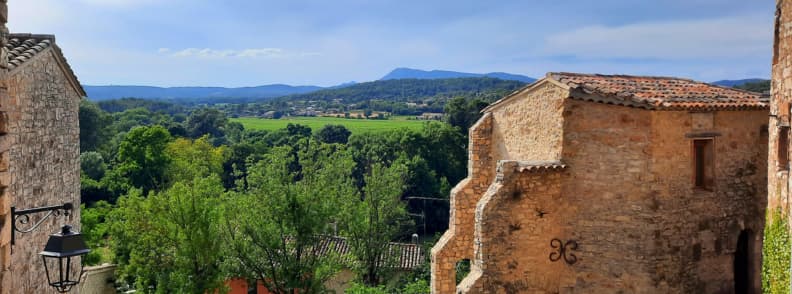Planning a weekend in Provence and craving something more than the usual tourist stops? Carcès, a medieval village in the heart of Provence Verte, is the kind of place that stays with you long after you’ve left. Surrounded by vineyards, lakes, and shaded river paths, this quiet Var village offers a mix of history, nature, and authentic Provençal life, and it’s perfectly placed for visiting the Cascades de Caramy, Lac de Carcès, and the Cistercian Abbaye du Thoronet.
Provence Weekend Guide to Carces
I recently spent a July weekend here with my husband and our toddler, arriving by camper and settling at Camping Fouguières, which turned out to be a friendly, very local spot where the owners knew everyone by name. From there, we explored Carcès old town, following its French heritage trail through narrow streets painted with trompe-l’œil frescoes, peeking into the Église Sainte-Marguerite, and catching a glimpse of a wedding celebration at the Château ruins. I remember the hum of celebration against a backdrop of medieval walls and tiled Provençal facades, it was wonderful!
On Sunday, we set off from the camping in Carcès toward the Caramy Falls along a shaded canal path. It was an easy walk at first, so we decided to tackle the longer loop to Lac de Carcès, and that’s when our leisurely hike became an adventure: sun-soaked trails, stunning views, losing the path for a while, running low on water, and coaxing our deeply sleeping toddler awake in the middle of nowhere. It wasn’t glamorous, but it was memorable. Exactly what a family weekend in Provence should feel like: real, imperfect, and beautiful.
This guide to visit Carcès is built for travelers who want more than a checklist. It combines personal insights with practical details: how to spend two perfect days between the Provence village, the waterfalls, and the abbey, where to stay, when to go, and how to make the most of this offbeat corner of Provence Verte.
Disclosure: Some of the links below are affiliate links. This means that at no extra cost to you, The Travel Bunny will earn a small commission if you click through and make a purchase. Thank you!
Why Carcès is Your Perfect Provence Escape
If you’re searching for a hidden gem in Provence, look beyond the glossy postcards of coastal towns and head into the Var. Carcès, set in the rolling green heart of Provence Verte, is exactly what travelers mean when they dream of an authentic Provençal escape. It’s a place where history, nature, and village life meet, and where you still feel like a guest, not another tourist.
A Hidden Gem of Provence Verte
Our first impression of Carcès France was that it felt like the kind of village you become part of, even if just for a weekend. We arrived at Camping Fouguières, tucked between vineyards and the river, where the owners greeted guests by name and knew the ages of the children splashing in the pool. It was easy to see this was a place for regulars, for families who return each summer to reconnect and unwind.
From here, everything was within reach: the French heritage-packed old town, the Cascades de Caramy, and the quiet Lac de Carcès. Tourisme Var often calls Carcès Provence Verte’s heart, and it makes sense. The village embodies the slower, greener side of Provence, the one locals hold onto while the rest of the region hums with tourists. This is the kind of spot you’d bookmark in an authentic Provence travel guide, then almost want to keep secret for yourself.
Carcès’ Medieval Heritage
Walking through the Carcès medieval village feels like stepping inside a living postcard. The cobbled streets twist between houses with facades vernissées (glazed tile), past fountains and shady squares that tell stories older than memory. You can follow the French heritage circuit toward the Château ruins, where we stumbled upon an unexpected scene: a wedding.
The Carcès castle, perched above the village, was alive with music, guests in bright summer clothes, and the laughter of a bride and groom posing for photos. This serves as a reminder that these historic places are also part of patrimoine français, still woven into everyday life. We didn’t linger long (we didn’t want to intrude or ruin their perfect photos), but even from the edges, it was nice to watch centuries-old stones frame such a joyful day. This is medieval Provence at its best: deeply rooted in the past yet full of present life.
The Legend of the Golden Goat (Cabro d’Or)
Every Provençal village has its legend, and in Carcès, it’s the Cabro d’Or, the Golden Goat. As the story goes, this enchanted goat guards a treasure hidden by the Knights Templar, appearing only on nights of the Mistral wind or under a full moon. Locals swear you can still sense her presence in the castle ruins, a flicker of gold in the corner of your eye. Whether you believe in the tale or just love folklore, the légende de la chèvre d’or Carcès adds a layer of mystery to an already captivating village.
A Complete Weekend Itinerary to Visit Carcès
Spending a weekend in Carcès (or a week-end à Carcès for French speakers) means immersing yourself in authentic Provence, exploring a Var village full of history, admiring vernissées façades along narrow lanes, and tasting the flavors of a region celebrated as the heart of Provence Verte. This itinerary blends the top things to do in Carcès with local secrets that make this hidden gem of Provence worth adding to any authentic Provence travel guide.
Day 1. Exploring the Village
If you only have one day in Carcès, start with the village itself. It’s compact but packed with history and details that reward a slow pace. It’s the kind of destination where you spot something new every few steps.

Afternoon Walk Through Carcès Old Town
Arriving in Carcès France on a warm Saturday afternoon, we settled at Camping Fouguières and set off to explore the village. On the way there, we passed by a sunny park on the river bank, with a couple of benches, a picnic table, and a small pebbled beach. Mathieu had never been to Carcès before, but he told me that spot resembled one he had dreamed about several times.
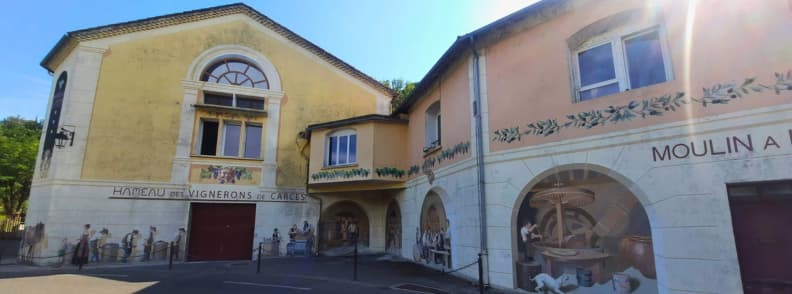
Then, right before arriving in town, we walked by the Hameau des Vignerons de Carcès. Pushing our son’s pram through the narrow, cobbled streets immediately slowed us down, but in a good way. This is a place meant for wandering. The cave coopérative, founded in 1910, has shaped the landscape and daily life of Carcès for over a century.
Today, it brings together over 100 cooperative members who farm 550 hectares of vines across Carcès and surrounding communes. Their methods remain traditional and environmentally respectful, rooted in a deep love for the land. The soils (mostly clay and limestone) are the same found in some of Provence’s most celebrated vineyards. That terroir gives their wines a pronounced identity: bright, fruit-forward, and full of freshness.
The Hameau des Vignerons produces both AOP Côtes de Provence and IGP vins de pays du Var, in red, white, and rosé. But they also make olive oil, pressed on-site in a pre-revolutionary mill powered by water from the Carcès canal. Every November, the old stone wheel turns again. Crushed olives go straight under the press to create their highly reputed oil. And if you visit at the right moment, you might catch the warm scent of the roustide, a traditional snack prepared by the master miller at the fireplace.
Environmental stewardship is at the heart of the Hameau. They’ve long been pioneers in the Var for waste treatment: their biological filtration system lets them discharge clean water from the cellar. Since 2018, the cooperative has been working toward the HVE (Haute Valeur Environnementale) certification, with annual third-party evaluations of biodiversity, fertilisation practices, phytosanitary strategy, and water management.
Carcès Local Tip: Tastings and sales of wine and olive oil happen right in the village cellar shop. It’s a great place to pick up a bottle that reflects Carcès’ landscape, climate, and community.
We mostly followed the Carcès heritage trail, a self-guided walking tour through centuries of history. It begins at Place de la Respelido, a square that buzzes with village life, where the weekly market fills the air with the smell of fresh bread, herbs, and lavender every Saturday morning.
From there, we climbed toward the Château ruins, perched like a guardian above the town. Originally built in the 11th century, this Carcès castle began as a simple fort before being modified in the 13th century and later rebuilt and extended during the 16th century to overhang the Place Bramadou. The round half‑tower, still visible today, once formed an integral part of its defensive system. To the vestiges of the main body, dating from the 13th and 16th centuries, is added an octagonal Renaissance stairwell, a rare architectural feature that speaks to the castle’s evolution over time. On the right side, oriented to the south, there was once a wing adjoining the castle, though it has completely disappeared now.
The esplanade we stood on corresponds to what would have been the first floor of the castle, partially laid over the 11th‑century fortress walls. From here, the Lord’s apartments once overlooked the village below, a reminder of the power and presence this building once commanded.
That day, this patrimoine français was alive again. It served as a backdrop for a wedding. We arrived just as the bride and groom were posing for photos with their guests, their excited chatter echoing off the ancient stones. We stepped aside quietly, not wanting to disturb, but it was moving to see living traditions take place within these enduring walls.
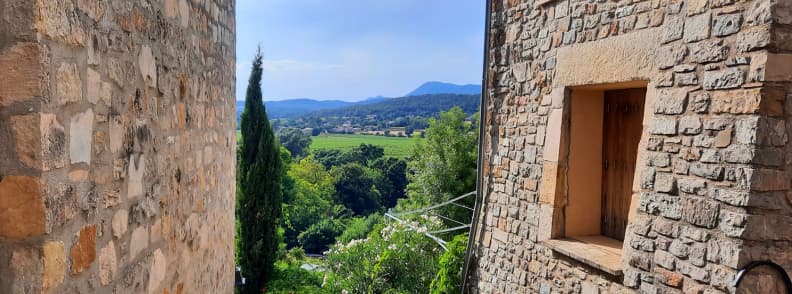
The trail later led us through the Porte des Brignoles and Porte des Lorgues, two of the village’s original fortified gates, reminders that Carcès was once an important stronghold in the Provence médiévale.
We paused at Place du Bramadou, a quieter spot where pastel houses with façades vernissées glowed in the light. This square was created in the 16th century when the inhabitants of Carcès began moving outside the protective walls, building their homes right up against the ramparts. Its name comes from the Provençal word Brama, meaning to cry out, a nod to its history as the village’s cattle market, once full of noise and barter.
Along Boulevard Clemenceau, some houses still display their original 19th‑century glazed earthenware tiles from Salernes, which also protect the façades from bad weather, a clever and beautiful solution that has endured for over a century.
Here, Place Bramadou also reveals Carcès’ love of storytelling through art. On one side, the Var Tourism Office façade features a detailed mural filled with scenes and symbols from local life. Across the street, the Louis XIV arrives in Carcès mural captures a key moment in French history, blending the village’s humble square with the grandeur of a royal visit.
From there, we wandered into the Quartier‑sous‑Ville, a neighborhood where narrow passages conceal fountains and artisan workshops, reminders that Carcès is as much about living tradition as it is about preserved history.
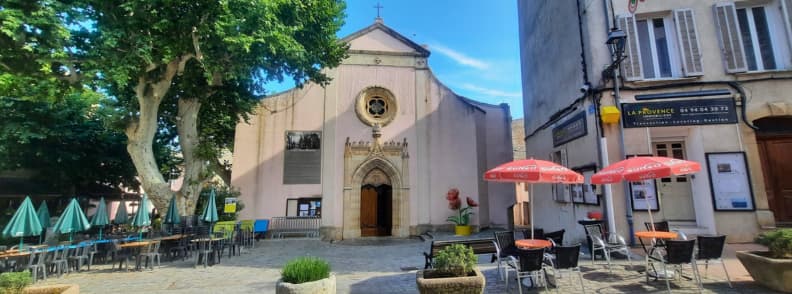
A nice stop was the Église Sainte-Marguerite, a modest but beautiful church that feels like the spiritual heart of the village. Stepping inside, I learned it belongs to the same network as the Sainte Roseline Chapel, connecting this humble parish to one of Provence’s most celebrated sacred sites. Another thing that surprised me was the confessional booth in the chapel on the right. It’s becoming increasingly rare to see confessional booths in Catholic churches. (They are getting replaced by confessional rooms.)
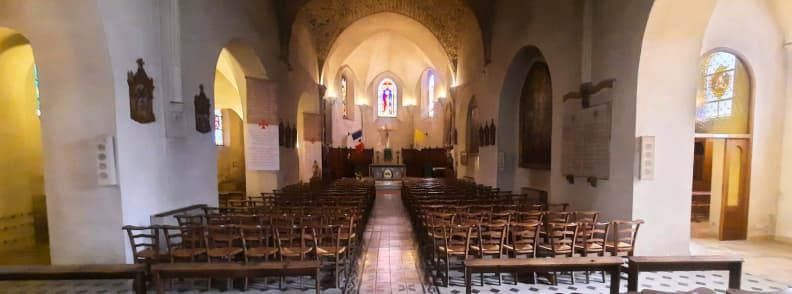
On a noticeboard inside, I spotted a poster for the Fête Patronale Sainte‑Marguerite, celebrated on the Saturday closest to 24 July. The program included a Soupe au Pistou dinner, an animated shared meal with proceeds benefiting the parish, where guests were asked to bring their own plate and cutlery. There was also a tasting of the Cuvée Sainte‑Marguerite from Domaine Foussenq, followed by a Sunday morning procession through the streets, blending faith, food, and local wine in a way that felt quintessentially Provençal.
From Église Sainte‑Marguerite in Carcès, we made our way along Rue Maréchal Foch toward the City Hall, which stands proudly next to the Clock Tower, a landmark that once helped the village keep time in an age before watches and smartphones. This is Place de la Mairie, previously named Place Caucadis, part of the Jas Neuf district that was expanded during the 17th and 18th centuries. At that time, Carcès grew eastward from the Sous Ville district along Rue de l’Horloge and Rue Jean Bremond, stopping at the Saint‑François Gate, just opposite the church.
The Clock Tower, crowned by its iron campanile, was built in the latter half of the 18th century, as was the fountain that still anchors the square. This Four Seasons Fountain, constructed in 1722 and improved in 1810 during the construction of the new town hall, adds a symbolic layer to the square. Its bust‑topped column, which replaced an imperial eagle, was installed at the end of the 19th century to commemorate the centenary of the French Revolution.
The Town Hall itself dates to 1811, a civic center that has seen generations pass through these streets. For many years, two cafés coexisted on this square: Café de la Paix and Café National. Though the Café de la Paix closed in the 1990s, the Café National holds its own history. In the 1910s, it organized open‑air cinema screenings, with the projector set up on the balcony and the screen stretched against the fountain’s column, turning this square into an early Provençal movie theater.
Standing here today, with the Clock Tower above and the fountain at its heart, the square feels layered with centuries of Carcès life, where civic, social, and cultural histories intersect in one remarkable space.
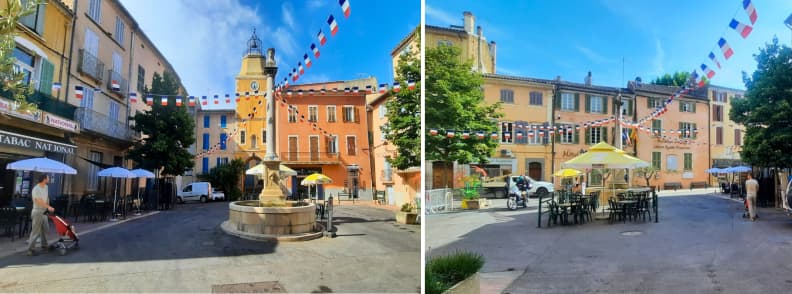
And then there were the frescoes, a delightful surprise. Besides the ones I mentioned above, the Rue du Moulin mural caught my eye as we headed back toward the camping. These works are a celebration of local life, painted stories that keep Carcès’ identity alive for all who visit. And, if properly maintained in time, a creative way to beautify the exterior of otherwise simple walls, some even eye-sores without a splash of color on them.

On the way back, we walked over a wooden bridge to pass on the other side of the river. We passed by the Parking Espace communal Le Coude, an excellent itinerary for off-camping. It’s next to the river, in a quiet spot, and a lot more shaded than it looks on the Google Maps satellite view. It’s a great alternative if you don’t want to take your camper/van to the Carcès camping.
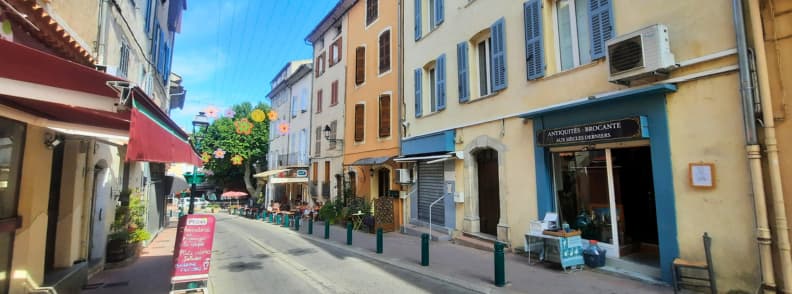
Eating in Carcès
Walking through Carcès is also a slow reveal of its food culture. Every corner seems to offer a new temptation. One that immediately caught my eye was Le Madras, a Creole restaurant promising vibrant flavors. It’s the kind of unexpected find that makes hidden gems in Provence even more exciting. We couldn’t try it this time, with William still too little to sit through a meal. But it’s on my list for our next trip.
For a taste of authentic Provence, L’Oie qui Boite is a cozy bistro known for its homemade dishes made from local ingredients, perfect for an unhurried dinner. And for something more casual, La Guinguette du Lac offers simple, hearty plates by the water, ideal for a laid-back meal before heading back to your campsite or rental.
If you’re there on a Saturday morning, the Provençal market is unmissable. This is where Carcès comes alive: stalls overflowing with olives, goat cheeses, sun-dried tomatoes, honey, and freshly baked fougasse. You can piece together a picnic from market goodies and find a quiet spot under the plane trees. Sometimes the best meal isn’t in a restaurant at all.
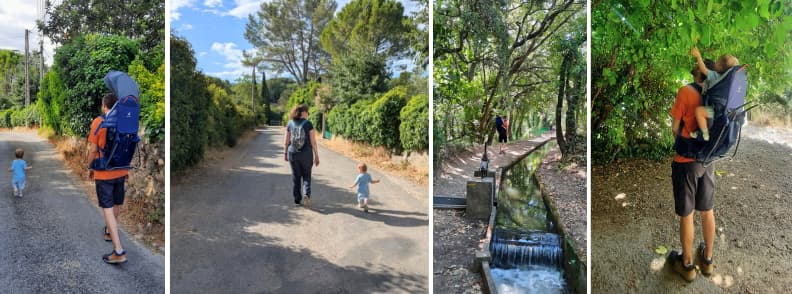
Day 2. Hike to Cascade de Caramy & Lac de Carcès
No weekend in Carcès is complete without venturing beyond the village streets and into the wild heart of Provence Verte. On your second day, trade cobblestones for riverside trails and enjoy one of the region’s most scenic hikes: the Cascades de Caramy and Lac de Carcès loop. This combination brings together hiking in Provence with Provence waterfalls, lakeside walks, and moments of pure calm that make you appreciate why this corner of the Var is such a haven for outdoor lovers.
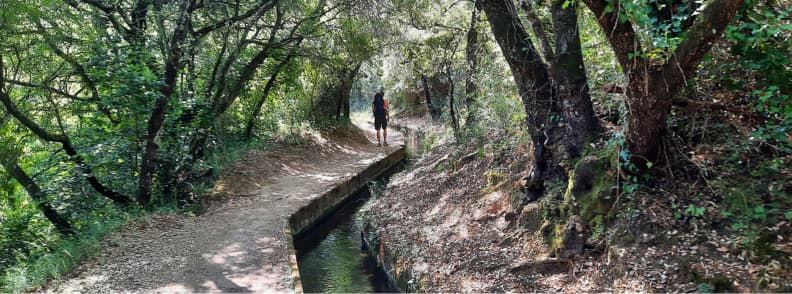
Morning Hike to Cascades de Caramy & Lac de Carcès
We set out from Camping Fouguières early, following a shaded irrigation canal that winds toward the Cascades de Caramy. It’s a pleasant, flat stretch perfect for families. The trailhead is easy to reach on foot if you’re staying in the village or by parking near the Notre-Dame de Caramy chapel for those coming by car. This part of the Caramy Falls trail is well-marked, and the dappled light through the trees kept us cool even in July.
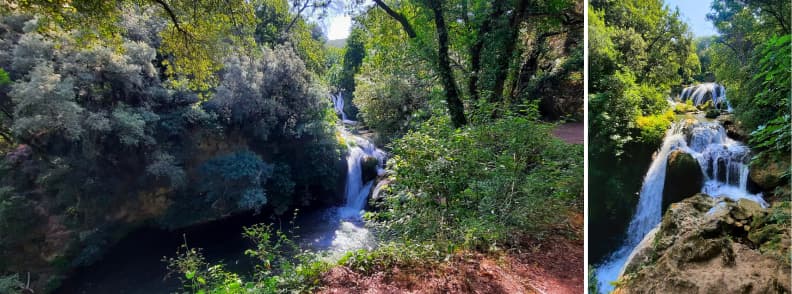
Soon, we reached the Chutes du Caramy, a tall double waterfall. From the secure viewing platform, you can take a rough path a few meters down for a better view. There, you can feel the spray as a welcome refreshment in Provence’s summer heat. For most visitors, this out-and-back trail is enough: an easy Var hiking trail that takes around 45 minutes each way. But we wanted more.
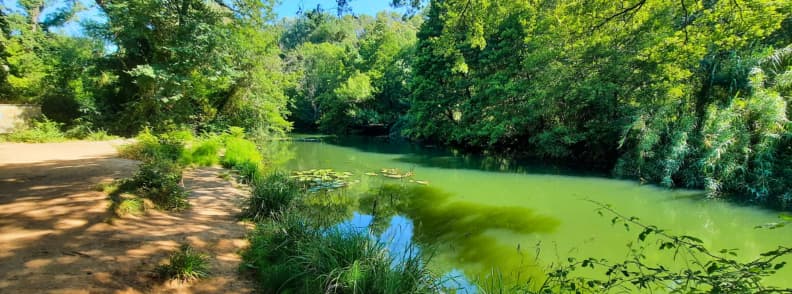
That’s when I suggested the extended loop: a randonnée Cascades de Caramy that continues past the falls, linking to Lac de Carcès (also known as Lac Sainte-Suzanne).
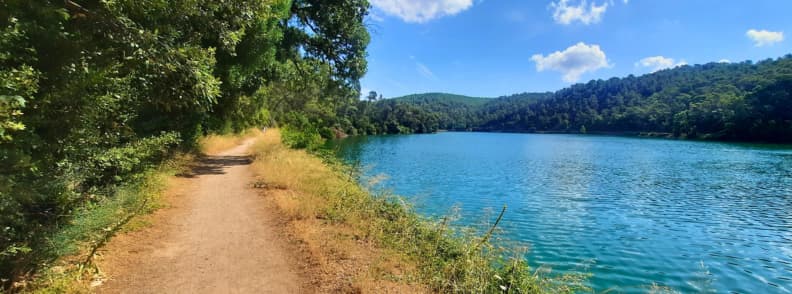
This section is where the hike transforms. The trail gradually opens up to the shoreline of Lac de Carcès, a vast 100-hectare reservoir with nearly 8 km of shoreline. On that summer morning, the dam was half-open, a reminder of the lake’s role as a managed reservoir that sometimes gets partially drained for maintenance.
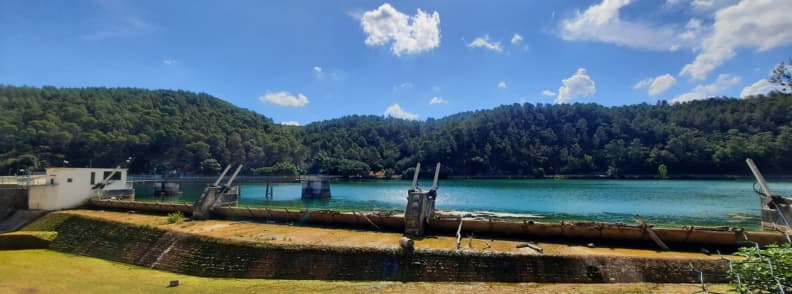
We walked along its edges, passing locals fishing from quiet spots. This is a well-known site for pêche Lac de Carcès. We also spotted a few families unpacking their lunches to have a picnic. Despite its inviting water, bathing in Lac de Carcès isn’t allowed since it supplies drinking water to Toulon, but it’s still a gorgeous place for a pause and to appreciate the stillness.
Next to Domaine de Brauch – Maison de la Pêche & de la Nature, the trail leaves the shoreline and climbs uphill along a quiet road that circles the higher ground around the lake. We passed by the Site de Brauch, a rock climbing spot, and the starting point of the Carçoise VTT trail.
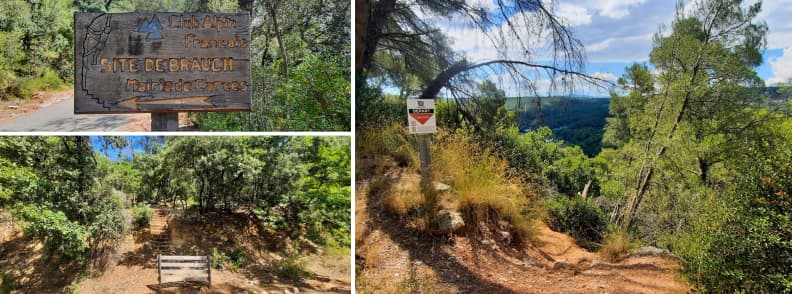
This part has little shade but rewards you with breathtaking panoramic views of the Provence Verte countryside with rolling vineyards, wooded hills, and a sweeping view of the lake shimmering below. Afterward, the path cuts through woods and vineyards, leading you back toward Carcès. It’s a route that shows the diversity of the Var hiking trails: lakeside calm, open Provençal landscapes, and finally shaded forest paths.

At the point when we were supposed to switch from the road to the path in the woods, we lost the trail. That’s when the hike became an adventure. Our son, lulled by the heat and the carrier’s sway, fell into such a deep sleep that we couldn’t wake him. (It wasn’t the first time this happened, but it’s still scary). We were running low on water (keeping his supply untouched, of course), hadn’t seen another hiker or car for an hour, and for a brief moment, panic set in. Then, following what looked like a wild boar path, we eventually reached a proper trail. I’ve never been so grateful for pig-made shortcuts.
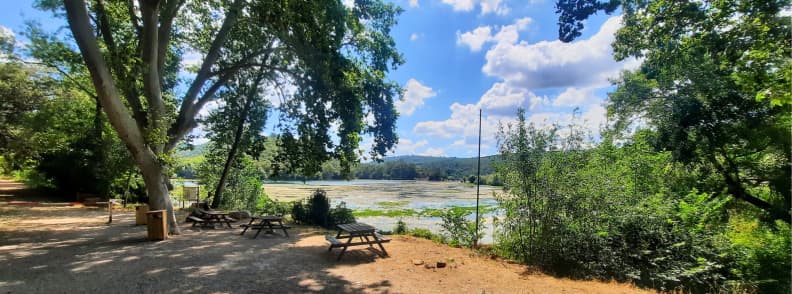
Lac de Carcès Picnic or Lunch Back in Town
After hours on the trail, lunch is best kept simple: either a picnic on the shaded tables by the lake (perfect if you packed market goodies) or a quick meal back in the village. There’s something special about eating local cheese and fougasse in sight of the calm lake, even if you can’t swim in it.
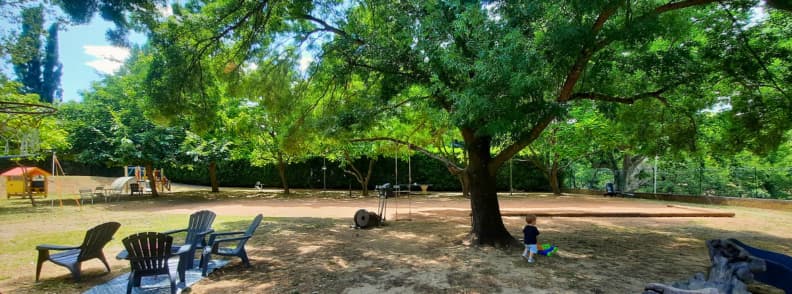
Afternoon Fun & Relaxation in Camping Fouguières
In the afternoon, we took it easy at Camping Fouguières. William had his fill of playtime in the playground. Besides a swing, a slide, and other such toys for kids, a volleyball court, a ping-pong table, and pétanque terrains, they also have quirky touches like a random elliptical bike and a snowboarding-style toy for teens. We lounged on some chairs on the lawn next to the closed snack-bar Le cabanon while he played. And then we headed to the swimming pool, where William finally got accepted to put on his new buoyancy system, splashing around happily with us
Dinner from Snack-Bar Le Cananon in Camping Fouguières
For dinner, we joined the Camping Fouguières crowd for their Sunday burger night, a communal, no-frills experience that looked like sharing a meal with neighbors. But as we wanted to put William to bed early, we chose to eat in the camper. So they improvised takeout for us: fries served in our own bowl, and burgers wrapped in foil. It’s this kind of friendliness that makes me want to stay at Camping Fouguières again when William’s a bit older and more used to switching his bed at home to one in the camper without problems.
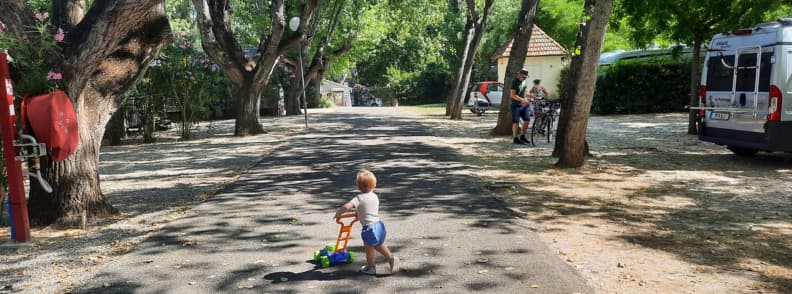
After dinner, William was still very energetic, so we went out for a walk outside the campsite, on a quiet country road next to vineyards. Our son kept falling in the dust as he was pushing his lawn mower, but he was having fun and didn’t mind at all. We returned to our camper when the light was dimming to wash off all the dirt before bedtime.
Like the evening before, after we put William to bed, we sneaked out of the camper to enjoy the cool air, the quiet, some cold sangria on the first evening and rosé wine on the second. It gave us a moment to ourselves, to slow down and to talk, to reconnect.
Day 3. Visit Beyond Carcès
If you have more time, extend your Var weekend itinerary and dive deeper into the Provence Verte attractions that surround Carcès. This extra day can balance history, culture, and outdoor adventure, giving you a fuller taste of what makes this part of Provence special. Whether you want to explore more Cistercian heritage, wander storybook villages, or enjoy lakes and gorges, the options for day trips from Carcès are plentiful.
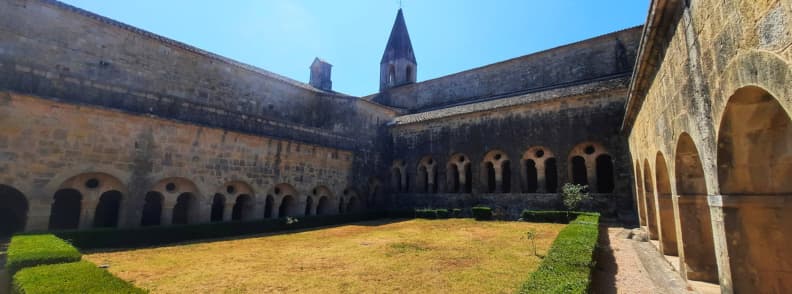
Visit Abbaye du Thoronet
On our way home, we stopped to visit Abbaye du Thoronet, one of the most remarkable Cistercian Abbeys in France. Built in the late twelfth century, the Thoronet Monastery is a place where simplicity becomes art. The thick stone walls and elegant arches of this French monastery are a reminder of how the Cistercian culture valued harmony and silence. It is one of the three sisters of Provence, alongside Sénanque and Silvacane, and visiting it is like stepping back into a world shaped by prayer and craftsmanship.
The Abbaye du Thoronet visit is as much about what you hear as what you see. Inside the church, the acoustics are extraordinary, and even a single note or a soft clap lingers in the space for seconds. This is why the abbey is also home to Les Musicales du Thoronet, a summer concert series that fills the stone halls with music in a way that feels timeless.
You can explore on your own or join a Thoronet guided tour. We chose to walk quietly through its rooms, reading the flyer that explained what we were seeing along the way, together with the abbey’s history and purpose. However, if you want context and more stories, a guided monastery tour makes all the difference.
The Abbaye du Thoronet horaires vary by season. In summer, you can usually visit between 10:00 and 18:00, while winter hours are shorter. Abbaye du Thoronet tickets cost €9 for adults, with free entry for EU residents under 26 and under 18 for everyone else, which makes it accessible to most travelers.
Nearby Villages, Outdoor Add-Ons, and Experiences
If you still have energy to explore, you will find plenty of things to do near Carcès that reveal the richness of Provence Verte.
Cotignac is only a short drive away and greets visitors with its dramatic cliffside troglodyte dwellings and one of the most vibrant village squares in the region. Correns offers a very different experience as France’s first entirely organic farming village, where everything from the produce to the wine reflects that commitment. Entrecasteaux feels like a journey into another century, with its seventeenth-century château and manicured gardens inviting slow exploration.

For a complete change of scenery, the Verdon Gorges, the Maures Massif, and the turquoise expanse of Sainte-Croix Lake are all within reach. These scenic backdrops are excellent destinations for hiking, kayaking, or simply breathing in some of the most beautiful air in southern France.
Back near Carcès, you can enjoy more personal experiences. If you love wine, you can visit domaines viticoles Carcès to taste and purchase vins de Carcès, enjoying the chance to talk directly with the people who make them. If you prefer adventure over tasting rooms, try horseback riding through the Provence Verte countryside or join a 4×4 safari to see the Var from a perspective few travelers experience. Each of these options adds another layer to your journey and makes a simple stay in Carcès part of a wider story.
Carcès Cultural & Artistic Heritage
Beyond its village streets and natural scenery, Carcès offers a deep connection to Provençal culture, layered with faith, artistry, and craftsmanship. This is a village where chapels still welcome pilgrims, murals tell local stories, and fountains and washhouses stand as reminders of a time when water was life and gathering places were at the heart of daily existence. (Water is still life in a region affected by drought almost every summer.)
Carcès Chapels & Pilgrimage Routes
Carcès has long been a place of spiritual significance. Scattered chapels mark centuries-old routes that still carry meaning for locals and travelers alike. If you follow the Chemin de Saint-Jacques Carcès, you are walking paths once taken by pilgrims on their way to Santiago de Compostela.
Notre-Dame de Carami
The Chapelle Notre-Dame de Carami sits just outside the village, near the trail to the Cascades de Caramy. This simple but evocative building has been a stop for travelers seeking comfort and protection for generations. It remains a quiet place to pause before or after a hike, offering views across the Caramy valley and a moment of stillness that feels far from the noise of modern Provence.
Chapel Saint-Jaume
The Chapelle Saint Jaume lies along The Way of St James. Its name actually echoes Saint James, the patron of pilgrims, and it has long been part of the journey for those walking the Chemin de Saint-Jacques Carcès. Visiting this chapel today is as much about connecting with history as it is about appreciating its rustic Provençal setting.
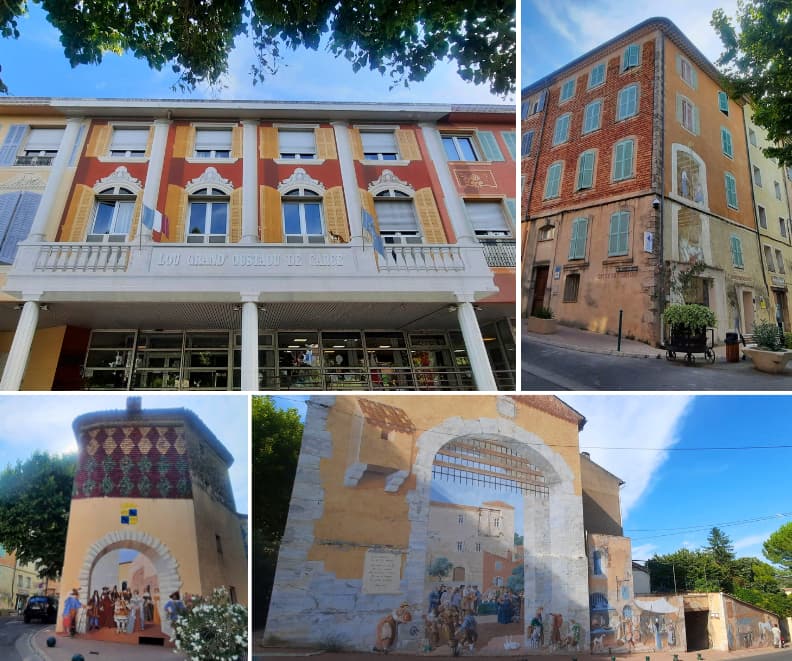
Carcès Frescoes and Trompe-l’Œil Murals
The Carcès murals are one of the village’s most unexpected delights. These fresques Carcès add color and character to the streets, turning ordinary walls into canvases. Many are painted in a trompe-l’œil Carcès style, creating illusions that blur the line between art and architecture.
You can spot them at the Jean-Jaurès car park, where a large mural greets visitors, at the Tourist Office façade, and along Rue Hoche, where scenes of local life unfold in painted detail. These decorations are a visual history lesson, celebrating the people and traditions that make Carcès what it is.
Fountains & Washhouses in Carcès
Carcès is also a village of water. Scattered throughout its lanes are Carcès fountains and lavoirs Carcès, public washhouses that once served as gathering points for villagers. These fontaines historiques Var are both practical and poetic, their steady trickle a constant reminder of Carcès’s connection to its rivers and springs.
Notable examples include the Four Seasons Fountain, the Fontaine de la Grouelette, and the Capalette fountain, each with its own character. Pausing by these fountains is a way to slow down and imagine life here before modern conveniences, when water drew people together and the sound of conversation mingled with the splash of buckets in the basins.
Carcès Annual Events & Local Life
Life in Carcès is closely tied to its events. These gatherings bring the community together, fill the village with color and music, and remind visitors that they are in the heart of a living, breathing part of Provence. For travelers, attending one of these celebrations is the best way to feel like a local, tasting the region’s culture in its most authentic form.
In May, Carcès blooms with creativity and beauty. The Fête du Livre turns the village into a literary hub, inviting authors and readers to meet in the Provençal sun. Around the same time, the Fête des Printemps et Les Floralies celebrate the arrival of spring with floral displays and market stalls bursting with seasonal produce.
July and August bring a different energy. Every Thursday evening, the marchés nocturnes Carcès light up the village with stalls selling artisanal goods, local delicacies, and crafts under the stars. These night markets are gatherings where music drifts through the streets, children play late into the evening, and visitors get to mingle with residents in a relaxed, festive atmosphere. During these summer months, the Festival Ce Soir au Château fills the château grounds with dance, music, and song, transforming historic walls into a stage for the arts.
The weekend of August 15 marks the Fête Locale Carcès, one of the most important dates in the village calendar. It is a celebration of Carcès itself, with parades, music, and shared meals that bring together generations of families and welcome outsiders into the fold.
As summer ends, the focus shifts to the land. In September, the Fête de l’Agriculture honors the farmers and traditions that keep Provence’s rural heart alive. In November, the Salon des Arts de la Table celebrates the art of dining, gathering artisans who create everything from elegant tableware to local culinary specialties.
In December, Carcès becomes especially magical. The Salon Gourmand au Château brings together food lovers in a celebration of local gastronomy, while the Marché de Noël turns the village into a Christmas postcard, with twinkling lights, holiday treats, and stalls selling seasonal crafts.
Throughout the year, the Provençal market every Saturday morning remains the village’s constant heartbeat. It is where locals gather to buy fresh produce, cheeses, and breads, but also where visitors can experience the sights, sounds, and flavors that make Provence unforgettable.
When we visited in mid-July, it was right before the Fête des Étoiles, a special stargazing celebration that transforms Carcès into an open-air observatory for one night. Next time, it will be at the top of my list!
Practical Information for Visitors
To make the most of your stay in Carcès, a bit of planning goes a long way. From finding the smoothest routes to choosing where to park, knowing the essentials will make your trip feel effortless. This section covers everything you need to navigate this Provence Verte village like a pro.
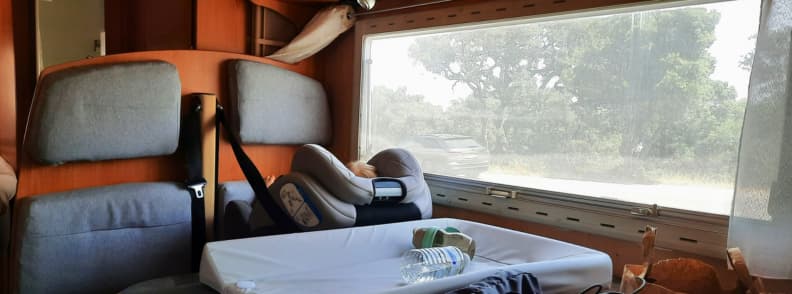
Carcès Directions. How to Get to Carcès & Around
If you are wondering how to get to Carcès, the village is easily reachable by car from major cities in the region. From Marseille, it takes about an hour and a half via the A52 and A8 motorways before turning onto the scenic D562. Coming from Nice, expect around a two-hour drive, following the A8 and then cutting through the French countryside to reach Carcès. These drives are part of the experience, with Carcès directions winding through vineyards, olive groves, and sleepy Provençal towns that make the journey feel like a prelude to your stay.
If you are relying on public transport, buses connect nearby towns like Brignoles and Draguignan to Carcès, but schedules can be sparse. It is worth checking in advance, especially if you are planning day trips or need to coordinate return journeys. Once you arrive, the best way to explore is on foot. The village is compact, and walking lets you take in its murals, fountains, and heritage spots at your own pace.
Carcès parking is straightforward. There are free spaces near the village center and additional parking areas close to the Cascades de Carami trailhead, such as by the Notre-Dame de Carami chapel.
If you are visiting by camper, Camping Fouguières is a welcoming base. That is where we parked our camper when we visited, which made everything easy. We walked everywhere from there, pushing William in the baby carriage along old streets and shaded paths. On our way home, we stopped at the Abbaye du Thoronet, enjoying a quiet visit before having lunch in the camper, parked in the abbey parking lot. It felt like the perfect way to end our weekend before continuing the drive home, with William enjoying his afternoon nap, protest-free.
Best Time to Visit Carcès
Choosing the best time to visit Carcès depends on what you want from your trip. Each season in Provence Verte brings its own character and rhythm.
In spring, the village and surrounding French countryside come alive. This is when the Cascades de Caramy are at their most impressive, fed by winter rains, and the wildflowers brighten the trails. The temperatures are mild, and the village feels relaxed, making this the meilleure période Carcès for hikers and those who prefer a quieter experience.
Summer turns Carcès into a lively hub. The days are hot and full of energy, with marchés nocturnes, concerts, and festivals drawing crowds into the village squares. If you enjoy lively villages and cultural happenings, summer is an excellent choice, but be prepared for crowds and plan accommodation well in advance.
When we visited in mid-July, the Carcès weather brought warm afternoons and pleasantly cool nights. Despite the heat, the shaded paths along the Caramy made the hike manageable, and the evenings felt magical.
Autumn is quieter and especially rewarding for food and wine lovers. This is harvest time in Provence Verte, and nearby domaines viticoles offer tastings of the season’s wines. The weather stays mild, making it a perfect balance between activity and relaxation.
Where to Stay in Carcès
If you are wondering where to stay in Carcès, you will find a mix of hébergement Carcès options to suit different travel styles. The village itself offers charming Carcès B&B stays, where you can enjoy the warmth of a family-run guesthouse, as well as vacation rentals that are ideal for longer visits or those who prefer more independence. For those seeking a more traditional hotel experience, nearby towns like Cotignac and Brignoles provide additional accommodations within a short drive, combining the calm of Carcès with access to slightly larger centers.
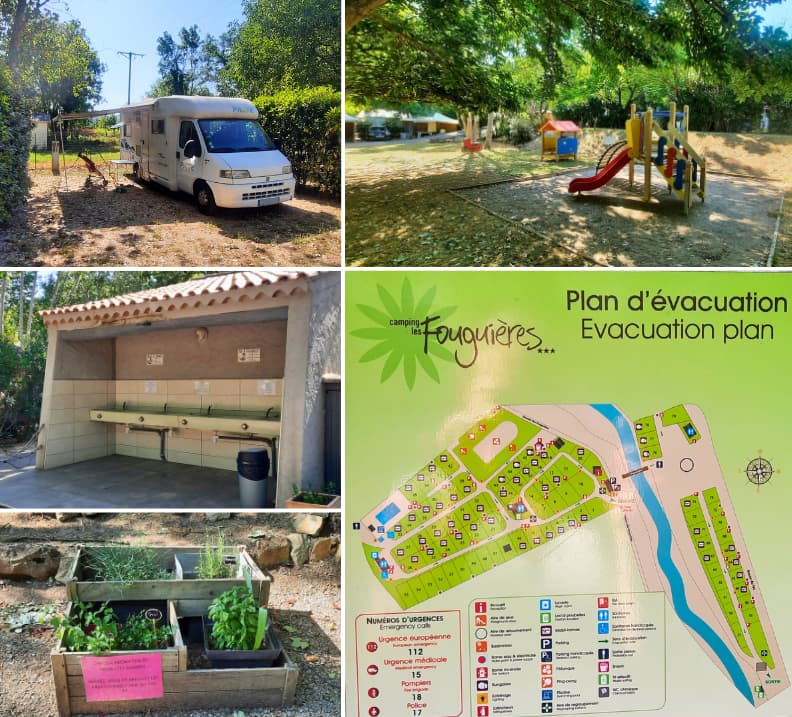
During our visit, we stayed at Camping Les Fouguières, and it quickly became clear why so many people return here year after year. This Carcès camping is not just a place to park your camper. It has the feel of a small community, with regulars who greet the owners by name and evenings spent chatting under the Provençal sky. The facilities make it an easy choice for families.
There is a shaded Aire de Jeux with equipment that kept William entertained for a long time. For adults and older kids, there is a volleyball court, pétanque terrain, a ping-pong table, and even an elliptical bike. The swimming pool provided a refreshing break in the afternoon heat, and I especially appreciated the shaded seating area where parents could relax while keeping an eye on their children.
For travelers who prefer to immerse themselves in the daily rhythm of village life, staying within Carcès is ideal. The compact size of the village means you can easily walk to the Saturday market, local restaurants, and cultural landmarks, making your accommodation feel like an extension of the experience. Whether you are choosing a cozy B&B, a practical rental, or the sociable setting of a campsite, où dormir à Carcès is less about luxury and more about feeling at home in the heart of Provence Verte.
Booking Tips and Seasonal Considerations
When planning where to stay in Carcès, timing matters as much as the accommodation itself. During the summer months, especially in July and August, the village fills with visitors attending the marchés nocturnes, Provence festivals, and the Fête Locale Carcès. If you want a spot in a Carcès B&B or a pitch at Camping Fouguières, it’s best to book well in advance. Spring and autumn are quieter and often more affordable, making them the meilleure période Carcès for travelers seeking a calmer experience while still enjoying mild Carcès weather.
If you’re camping, check whether the site offers shaded pitches. They make a big difference on hot Provençal afternoons. Our spot was shaded part of the day, which was great to charge our solar panels without being too hot inside.
For rentals or B&Bs, ask about proximity to the Saturday Carcès market and restaurants on Rue Maréchal Foch, which makes for an easy, car-free stay. Families like ours may prefer Carcès camping, which offers safe play areas for children and the flexibility to cook or dine outdoors.
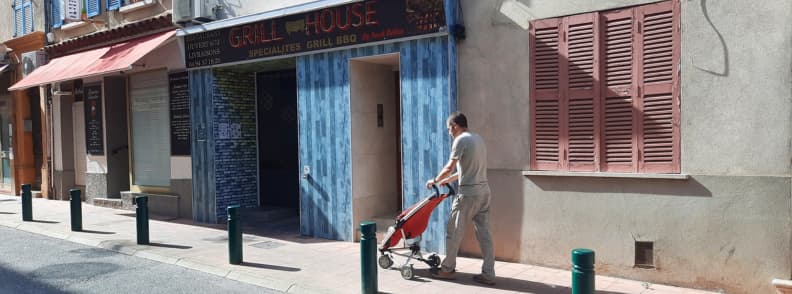
Family-Friendly Considerations
Visiting Carcès with children is as rewarding as it is manageable. The village’s compact size, shaded streets, and relaxed pace make it easy to explore even with a poussette. On our visit, we pushed William comfortably along Rue Maréchal Foch, stopping for breaks at quiet squares and peeking into murals that sparked his curiosity.
For families, Camping Fouguières is a standout choice. It offers a shaded playground for children of all ages (toddlers to teens). There are pétanque terrains, a volleyball court, and a ping-pong table, giving plenty of space for active play. The swimming pool was a highlight for us, where William finally felt confident wearing his new buoyancy system, happily splashing under our watchful eyes.
When hiking, the Cascades de Caramy trail is perfect for families. It’s shaded, flat for the most part, and short enough for children to enjoy without getting exhausted. For toddlers, like our son, a carrier is essential. If you attempt the longer loop to Lac de Carcès, be mindful of sun exposure and bring extra water.
The village also hosts several Provence festivals and events that welcome children, like the Fête Locale Carcès in August and the Saturday market, where little ones can taste local produce and enjoy the lively atmosphere.
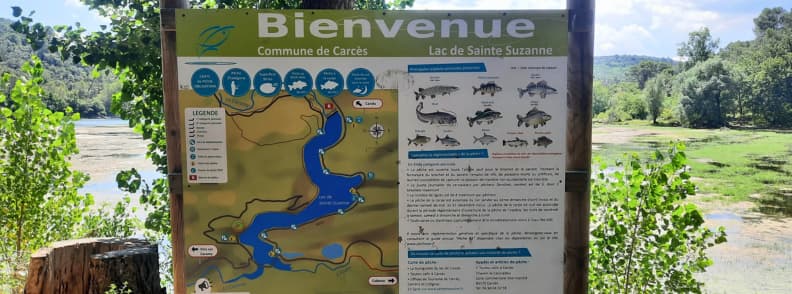
Fishing at Lac de Carcès
Lac de Carcès, also referred to as Lac de Sainte‑Suzanne, is a well-known fishing spot in Provence Verte. Covering a surface area of 99 hectares, it is classified as a 2nd‑category fishing lake, which means that a Carte de Pêche is mandatory. You can purchase one at the Guinguette du Lac de Carcès, at Toutou Câlin in Carcès, at the Tourist Offices in Carcès, Correns, and Cotignac, or online at cartedepeche.fr. Bait and fishing supplies are also available at Toutou Câlin in the village.
Carp fishing is authorized from January 1st to the second Sunday in April, and from the last Saturday in May to December 31st. Carp night fishing is authorized on weekends (from Friday to Monday nights) during the open carp fishing periods.
Fishing here is strictly regulated. Lac de Carcès is home to a wide variety of species, including pike, common perch, zander, catfish, black bass, carp, rudd, roach, and bream, alongside catfish and pumpkinseed fish, which are considered species likely to cause ecological imbalance and cannot be transported alive. Black bass and carp fishing is strictly no‑kill, meaning all catches must be immediately released.
In this 2nd‑category water, fishing is open all year except for pike and zander during their closed seasons. During these closures, it is prohibited to use live bait, dead fish, artificial lures, or any gear likely to catch these fish intentionally. The daily catch quota for predator fish (pike and zander) is three per angler, of which no more than two can be pike. Anglers may use up to four lines each.
Regulations here are detailed, so it’s worth consulting the annual Guide Pêche 83, available from local vendors or on the Fédération de pêche du Var website, before you set up your gear.
Packing & Safety Tips
A successful trip to Carcès depends on how well you prepare. These Carcès travel tips will help you enjoy the village and its surroundings comfortably and safely.
If you are planning to hike the Cascades de Caramy or explore the extended loop to Lac de Carcès, make sure you bring sturdy walking shoes, plenty of water, and lightweight clothing suited for the season. In summer, add sun protection like hats, sunglasses, and high-SPF sunscreen to your Provence packing list, as the uphill sections of the trail have little shade. A small backpack with space for a picnic is also a good idea. You’ll love having fresh bread, cheese, and fruit from the Saturday market ready for a break by the lake.
For safety, take extra care on longer trails. This is especially true if you are walking with children or, like us, carrying a little one in a baby carrier. Keep an eye on trail markers, carry a fully charged phone, and let someone know your route. These small steps make a big difference for sécurité randonnée Carcès, particularly in the hotter months when getting lost or running out of water can become serious quickly.
Lastly, know where to find help if needed. Carcès has a pharmacy and a small medical office, and Brignoles, about a 20-minute drive away, offers larger medical facilities. Being prepared ensures you can focus on the beauty of this Provençal gem without worry.
Carcès Frequently Asked Questions (FAQs)
If you are planning a trip to this Provence Verte village, these answers to common questions about Carcès will help you prepare for your visit with confidence.
How do I get to Carcès from Nice?
From Nice, the easiest way to reach Carcès is by car. It takes about two hours via the A8 motorway, then following local scenic roads through Provence Verte. If you rely on public transport, you can take a train or bus to Brignoles or Draguignan, then transfer to a regional bus to Carcès, though connections can be limited.
Where can I park at Lac de Carcès?
You can park near the Notre-Dame de Carami chapel, which is convenient for accessing both the Cascades de Caramy trailhead and the lake. There are also small parking areas near the Domaine de Brauch and the dam, though they can fill up quickly on weekends.
Why is Lac de Carcès empty?
At times, you may find Lac de Carcès with noticeably low water levels. This is because the lake is a managed reservoir that supplies drinking water to Toulon. It is periodically drained or partially emptied for maintenance and cleaning. When we visited in July, the dam was half-open, and the water level was lower than expected, though still beautiful for a walk along the shore.
Can you swim in Lac de Carcès?
No. Swimming in Lac de Carcès is prohibited, as it is a protected water source. While the lake looks inviting on a hot summer day, signs around the shore make it clear that bathing is not permitted. Instead, locals enjoy fishing or relaxing at the picnic tables along its edges.
How long is the Cascades de Caramy hike?
The Cascades de Caramy out-and-back trail is an easy walk of about 45 minutes each way, making it manageable even for families with children. The extended loop we took, connecting the waterfalls to the lake, took several hours and included uphill sections with little shade. It was worth it for the sweeping views of the French countryside, though it turned into quite an adventure when we briefly lost the path through the vineyards and woodlands.
Is the Cascades de Caramy hike suitable for children?
Yes, the out-and-back hike to the Cascades de Caramy is suitable for children. It is mostly shaded, with a gentle slope and plenty of places to pause. For toddlers, like our son, a carrier or stroller designed for rougher terrain is helpful. The extended loop to Lac de Carcès is better suited for older kids, as it involves sun exposure and steeper sections.
Are dogs allowed at Cascades de Caramy?
Yes, dogs are allowed on the Cascades de Caramy trail, provided they are kept on a leash. It’s a popular walk for locals with pets, but make sure to bring water for them, especially if you plan to attempt the extended loop to the lake where shade is limited.
When is the Carcès market?
The Carcès market takes place every Saturday morning. It fills the village with the scent of fresh bread, ripe cheeses, and seasonal produce. This is where you can gather picnic supplies for your hike, and it’s also the best way to meet locals and get a taste of daily Provençal life.
What are Abbaye du Thoronet opening hours & ticket prices?
The Abbaye du Thoronet is generally open from 10:00 to 18:00 in the summer months, with shorter hours in winter. Tickets cost €9 for adults, and entry is free for EU residents under 26.
Is Carcès worth visiting for a weekend?
Absolutely. Between its murals, medieval heritage, and lively Saturday market, the Cascades de Caramy, the Lac de Carcès, and its proximity to Thoronet Abbey, Carcès offers a perfect balance of culture, nature, and Provençal charm. For us, staying at a friendly campsite like Camping Fouguières made the experience even more memorable, giving us the chance to relax after exploring the village and hiking the surrounding trails.
Plan Your Own Weekend in Carcès, Experience Provence Differently
A weekend in Carcès is a chance to slow down in the heart of Provence Verte, walk cobbled streets lined with murals and fountains, hike to the Cascades de Caramy, rest by the peaceful Lac de Carcès, and step inside the quiet stone halls of the Abbaye du Thoronet. It is lively on market days and during Provence festivals, yet tranquil enough that you can still hear your footsteps echo in the medieval lanes.
For us, staying at Camping Fouguières turned our visit into something special. It was a simple, family-friendly base where we could cook, relax, and share evenings under the Provençal sky. Whether you choose a Carcès B&B, a rental, or a campsite, you will find yourself welcomed into a village that still feels real, shaped by its people, its history, and its traditions.
If you are looking for authentic Provence, with a mix of culture, nature, and the warmth of a small community, plan your own trip and experience Carcès the way we did.
About the Author

I’m Mirela Letailleur, a travel guide author based in the South of France and the creator of The Travel Bunny, a blog where I share practical, story-driven guides to help you explore Europe like a local. Living in Provence gives me the chance to experience places like Carcès, Provence Verte, and the Var region firsthand, not just as a visitor but as part of the community.
My expertise comes from years of slow travel across France and beyond, often with my family, exploring hidden villages, cultural landmarks, and scenic hiking trails. I’ve hiked to the Cascades de Caramy, walked the heritage circuit of Carcès, and stayed at local campsites like Camping Fouguières, giving me a personal understanding of what makes this corner of Provence worth visiting.
Through my work, I aim to provide detailed, experience-based travel advice that combines local knowledge, honest recommendations, and cultural context. Whether you’re planning your first weekend in Carcès or building a Var weekend itinerary, I share everything I’ve learned so you can travel smarter and experience the true essence of Provence.
After planning your Provence weekend in Carcès, check out these PACA guides
Provence in Spring. A Comprehensive Local Travel Guide
Life in a French Village. The Realities of Moving to the South of France
Bagnols-en-Forêt: Discovering the Hidden Charm of Provence

